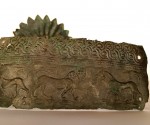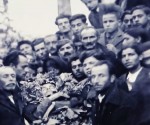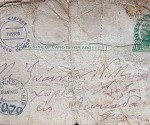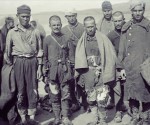Τι έγραφε ο Άγγλος περιηγητής D. T. Ansted το έτος 1863 για το μοναστήρι του Αγίου Γεωργίου στα Κολυβάτα και των Αγίων Πατέρων στη Νικιάνα
Ο Άγγλος γεωλόγος και περιηγητής David Thomas Ansted γεννήθηκε στο Λονδίνο το 1814 και πέθανε στο Μέλτον (Woodbridge, Suffolκ) το 1880. Σπούδασε στο πανεπιστήμιο Καίμπριτζ και στα 1840 έγινε καθηγητής της Γεωλογίας στο κολλέγιο Κινγκ του Λονδίνου.Το 1845 ανέλαβε καθηγητής της στρατιωτικής σχολής του Addiscombe και αργότερα δίδαξε στο κολλέγιο Putney του Λονδίνου. Ο Ansted δημοσίευσε εκτός από διάφορα επιστημονικά έργα και αρκετά ταξιδιωτικά από τις διάφορες περιηγήσεις του. Το 1863 ταξίδευσε στα Ιόνια Νησιά. Πέρασε και από τη Λευκάδα. Τις εντυπώσεις του από το ταξίδι αυτό τις δημοσίευσε σε βιβλίο που εκδόθηκε τον ίδιο χρόνο στο Λονδίνο με τίτλο «The Ionian Islands in the year 1863».
Στη Λευκάδα και στην ευρύτερη περιοχή της πρώην κοινότητας Αλεξάνδρου επισκέφτηκε μεταξύ άλλων το δάσος των Σκάρων (Scarus or Carus), το μοναστήρι του Αγίου Γεωργίου (Saint George of Scarus), που είναι χτισμένο στους πρόποδες του δάσους πιο πάνω από το χωριό Κολυβάτα, καθώς και το μοναστήρι των Αγίων Πατέρων, κοντά στο χωριό Νικιάνα, που το περιγράφει χωρίς να το κατονομάζει.
Για τις εντυπώσεις του από το δάσος των Σκάρων θα αναφερθούμε κάποια άλλη φορά. Εντύπωση προξενεί το γεγονός ότι στο μοναστήρι του Αγίου Γεωργίου βρισκόταν τότε μόνο δύο μοναχοί. Φαίνεται, ότι το άλλοτε από κάθε άποψη εύρωστο μοναστήρι, είχε αρχίσει να παρακμάζει. Δεν πρέπει βέβαια να ξεχνάμε ότι η Λευκάδα βρισκόταν ακόμη μαζί με τα άλλα Ιόνια νησιά υπό αγγλική κατοχή, που είχε φροντίσει για το οικονομικό ξεζούμισμα και των μοναστηριών. Αποτελούσαν ένα «ανεξάρτητο» κράτος-προτεκτοράτο, τις «Ηνωμένες Πολιτείες των Ιονίων Νήσων», υπό την προστασία της Βρετανίας. Με Σύνταγμα από το 1817 για το οποίο ο Σίδερις είχε γράψει σχετικά με αυτό: “Το Σύνταγμα τούτο συγκροτεί ουχί κυρίαρχον πολιτείαν… αλλά κράτος προτεκτοράτον της Μεγάλης Βρετανίας και στρατιωτικώς κατεχόμενον υπ’ αυτής”.
Παραθέτουμε πιο κάτω από το προανεφερόμενο βιβλίο «The Ionian Islands in the year 1863» τις αναφορές του Ansted στα Αγγλικά για τα δύο μοναστήρια. Λόγω μη επαρκών γνώσεων της αγγλικής γλώσσας δεν επιχείρησα να το μεταφράσω. Όποιος δεν κατέχει τα Αγγλικά θα μπορούσε να χρησιμοποιήσει online μεταφραστικά εγαλεία που αποδίδουν το νόημα. Αναφέρω δύο που χρησιμοποιώ καμιά φορά και υποστηρίζουν το συνδιασμό γλώσσας «Αγγλικά προς Ελληνικά»: Babel Fish Translation και metafrasi.gr
«…Most of the mountains in the Ionian islands have a religious house either at the summit or at the nearest convenient point. Some are large and regularly inhabited; some are only occupied during a part of the year when a festival of the patron saint is likely to attract a large multitude; some few are residences adapted only for one or two monks or nuns; and others are mere hermitages. Few of them have till lately been kept up in the old style, and, as in Roman Catholic countries there are scandalous tales afloat about the goings on when a convent and a monastery were adjacent. Nothing of this kind has tainted the fair fame of the monastery of Saint George of Scarus. The building is large, and there is fair accommodation for strangers. There are at present only two monks, venerable, kind, intelligent old men, knowing little and caring little for the world outside them. Their habitation is convenient, safe, and healthy. They possess all reasonable comforts, and they are willing as well as able to accommodate strangers in case of need.
The monastery being on the mountains is required to be made defensible against brigands as well as wolves. It is walled, and has double gates. There is a small court-yard on entering. On one side is the chapel, large in proportion to the population, and round two sides are the dwellings. There are perfectly plain, and very barely furnished. Opposite the chapel is the refectory, or feeding-room, and this serves as a place of extra accommodation in case of need. Near it are sleeping-rooms for strangers, and the cells, or rooms, of the monks. These are small, and often mere bare walls with a roof, a hole in the wall to let in air and light, and a door by which to enter. The floor is earth; but this is no great hardship in a warm climate; and as the Greeks all dress warmly, they can bear the temporary cold that sometimes occurs.
I have mentioned that there are only two monks regularly inhabiting the monastery of Scarus, and they pleasant, honest-looking, and hospitable. On first entering I was greeted warmly, with much shaking of hands, and proceeded to the chapel, where the different pictures were pointed out. I was then shown into the refectory, and seated on a kind of sofa, the two priests sitting opposite, while an attendant was preparing coffee. A decanter containing a little raki was first brought. I tasted a little, mixed with water, and found it very refreshing. Soon the coffee succeeded, and with it half-a-dozen slices of bread that had been air or sun dried so completely as to be perfectly hard and crisp, and nearly mouldy. This dried bread is a kind of biscuit. The coffee was excellent. After partaking of it, I asked to see a certain manuscript of the Gospels, of which I had heard, and both that and another in the possession of the brothers was brought out. Both were admirably written, and in excellent preservation; but they were not old. The curiosities of this kind that may once have existed in the Greek monasteries have long disappeared in the Ionian islands, and, indeed, except at Mount Athos, and in a few other places, there is little now to be learnt in such depositaries, so far as Europe is concerned.
The monks are simple, pleasant people, and one sees them with pleasure. They believe in the forms of their religion, and really practise their fasts, no doubt to the great mortification of the flesh; but the old celibates of this kind are few in number, and seem gradually dying out. It is impossible to go far in any direction without seeing some building devoted to religious purposes; but, in most cases, these buildings are only occupied once a year, on the occasion of the festival of the saint to whom they are dedicated.
Before leaving the monastery of Scarus, I was asked to give my name, which I wrote in the Greek character. As I had previously read a verse or two of the Gospel in one of the manuscripts, I found that it was considered very remarkable that I could read and write the Greek language, though I could neither speak nor understand Romaic. So completely is this the converse of the usual state of things in the country, where all, of course, speak, and very few read and write, that it was quite a phenomenon.
After quitting my friends, the monks, I went back from Scarus towards the town, by a shorter and more precipitous road than that by which I had come, and, an the way, stopped to look at a very striking and picturesque block of the conglomerate of the hills, which had fallen down, and stuck out from the mountain side in a singular manner. The exposed part of this vast block, as it projects from the ground, measured full fifty feet square, and nearly twenty feet thick. Underneath it was a large space, which had been walled in to make a shed for cattle, part of the stone forming the roof. Near the top, in a recess in the stone, was a little chapel, constructed in honour of three saints, whose portraits had once been painted on three little boards hanging up in front of an altar. Nothing remained of the paintings but parts of the gilt rings of glory that had once encircled the heads of the figures. All the rest had been long since kissed sway; but my companions, like many other persons, still most reverently saluted the dirty boards. The most curious thing was the presence of a well in the heart of the boulder, the water of which fills a cistern, said to be the coffin of one of the saints, and performing marvellous miracles. This must be a small, natural, artesian spring, derived from some crevise, perhaps connected which the falling of the rock from above. Besides this gigantic boulder, looking like the cap stone of a vast cromlech, there are many large stones, on the side of the hill, that have fallen down after being undermined by atmospheric action.
A curious appearance has been noticed in some of these blocks, both in their natural place on the rock and when fallen. Many of them are scooped out vertically, as if drilled by some enormous tool; or part of the stone being broken away, they look like gigantic seats sculptured artificially. This is, however, to be accounted for in a natural and easy way; and hundreds of cases of the same kind, in different stages of progress, may be observed on the rocks all round. They are the result of vegetation commencing on the surface of a block of the conglomerate, and eating its way down into the substance of the rock by the dissolving power of water…»




















































































